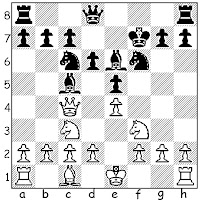First, some atmosphere from an interesting article by John Hilbert on "California Chess 1858-1859"
Interest in chess spread rapidly across the United States following Paul Morphy's sensational victory at New York 1857, followed by his triumphant European tour. New chessplayers and new clubs sprang up across the land, and the clubs already in existence gained greatly by the Morphy boom. California was no different. In its May 1858 issue The Chess Monthly, edited by Morphy and Daniel W. Fiske, reported that the chess bug had indeed hit the West Coast, and that a California Chess Congress inspired by Morphy and New York 1857 was being planned. Curiously enough, while The Chess Monthly detailed the course of the event, it did not provide any games from the tournaments. That detail was left to the pages of Frank Leslie's Illustrated Newspaper, which published five games from the top tournament. Coverage of the Congress on the East Coast was of course delayed by the lengthy distances such news had to travel. Three San Francisco chess clubs joined together to host the Congress: the Mechanic's Institute, the German Chess Club of San Francisco, and the Pioneer Chess Club. A committee of management was formed to take charge of the event, its members being Selim Franklin (President of the Congress), W. Schleiden, D.S. Roberts, Wm. R. Wheaton, Geo. Pen Johnston, Willard B. Farwell, Thomas Bryne, B.F. Voorhies, Edward Jones, Charles Mayne, M. Eilas, and H.R. Bacon. Entrance was fixed at five dollars, and players were to be divided into classes according to ability...Some more on the the 1858 tournament
...The Morphy chess boom, though, didn't last. Chess in the United States lost many of its gains in the years following Morphy's earliest and grandest successes. By March 13, 1861, a correspondent in California could write The Chess Monthly as follows:"During the latter part of 1858 and the beginning of 1859, while Mr. Morphy was pursing his unparalleled successes, the chess fever reached its height in San Francisco. Several chess clubs were formed, a grand Tournament was held, and all classes of the community were seized with a rage for playing chess. Since then the interest in our game has somewhat declined, and there is now no regular club in the city..."
The California Chess Congress of 1858 was one of the earliest tournaments in U.S. chess history. It was held at the Hunt's Building in San Francisco from March 22nd through May 1st. The chess congress was hosted by the Pioneer Chess Club, the German Chess Club and the Mechanics' Institute Chess Club, all located in San Francisco. The worldwide chess fever created by the 1857 world championship victories in New York by young Paul Morphy had reached the Pacific Coast. The 1858 Congress in San Francisco was covered in the May 1858 issue of The Chess Monthly and game details were provided in Frank Leslie's Illustrated Newspaper which published five games from the tournament. The event drew lots of spectators and match play continued past midnight. The President of the Congress was Selim Franklin, who came to San Francisco from London in 1849, and played chess in London and New York. The members of the organizing committee included W. Schleiden, Daniel S. Roberts, William R. Wheaton, Geo. Pen Johnston, Willard B. Farwell, Thomas Bryne, B.F. Voorhies, Judge Edward Jones, Charles Mayne, M. Eilas, and H.R. Bacon. The California Chess Congress began on Monday evening, March 22.Although the chess database has the game (which we will look at tomorrow) listed as "Byrne" - Farwell, the above listing suggests that it was between Thomas Bryne and Willard B. Farwell.









































.png)
.png)
.png)